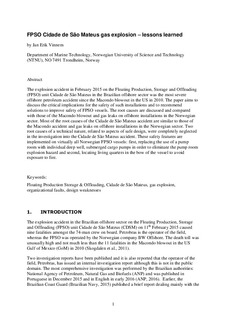| dc.contributor.author | Vinnem, Jan Erik | |
| dc.date.accessioned | 2019-02-20T14:43:45Z | |
| dc.date.available | 2019-02-20T14:43:45Z | |
| dc.date.created | 2018-11-25T15:08:41Z | |
| dc.date.issued | 2018 | |
| dc.identifier.citation | Safety Science. 2018, 101 295-304. | nb_NO |
| dc.identifier.issn | 0925-7535 | |
| dc.identifier.uri | http://hdl.handle.net/11250/2586593 | |
| dc.description.abstract | The explosion accident in February 2015 on the Floating Production, Storage and Offloading (FPSO) unit Cidade de São Mateus in the Brazilian offshore sector was the most severe offshore petroleum accident since the Macondo blowout in the US in 2010. The paper aims to discuss the critical implications for the safety of such installations and to recommend solutions to improve safety of FPSO vessels. The root causes are discussed and compared with those of the Macondo blowout and gas leaks on offshore installations in the Norwegian sector. Most of the root causes of the Cidade de São Mateus accident are similar to those of the Macondo accident and gas leaks on offshore installations in the Norwegian sector. Two root causes of a technical nature, related to aspects of safe design, were completely neglected in the investigation into the Cidade de São Mateus accident. These safety features are implemented on virtually all Norwegian FPSO vessels: first, replacing the use of a pump room with individual deep well, submerged cargo pumps in order to eliminate the pump room explosion hazard and second, locating living quarters in the bow of the vessel to avoid exposure to fire. | nb_NO |
| dc.language.iso | eng | nb_NO |
| dc.publisher | Elsevier | nb_NO |
| dc.rights | Attribution-NonCommercial-NoDerivatives 4.0 Internasjonal | * |
| dc.rights.uri | http://creativecommons.org/licenses/by-nc-nd/4.0/deed.no | * |
| dc.title | FPSO Cidade de São Mateus gas explosion - Lessons learned | nb_NO |
| dc.title.alternative | FPSO Cidade de S?o Mateus gas explosion - Lessons learned | nb_NO |
| dc.type | Journal article | nb_NO |
| dc.type | Peer reviewed | nb_NO |
| dc.description.version | acceptedVersion | nb_NO |
| dc.source.pagenumber | 295-304 | nb_NO |
| dc.source.volume | 101 | nb_NO |
| dc.source.journal | Safety Science | nb_NO |
| dc.identifier.doi | 10.1016/j.ssci.2017.09.021 | |
| dc.identifier.cristin | 1634657 | |
| dc.description.localcode | © 2017. This is the authors’ accepted and refereed manuscript to the article. Locked until 3.10.2020 due to copyright restrictions. This manuscript version is made available under the CC-BY-NC-ND 4.0 license http://creativecommons.org/licenses/by-nc-nd/4.0/ | nb_NO |
| cristin.unitcode | 194,64,20,0 | |
| cristin.unitname | Institutt for marin teknikk | |
| cristin.ispublished | true | |
| cristin.fulltext | postprint | |
| cristin.qualitycode | 1 | |

